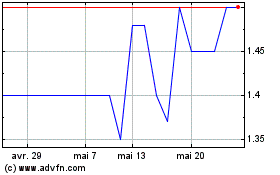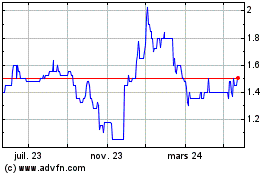Further re White Rock Scoping Study Confirms Viable Project
06 Juillet 2007 - 11:53AM
UK Regulatory
Anglesey Mining plc
6 July 2007 LSE: AYM
White Rock Scoping Study confirms Viable Project
Anglesey Mining plc is pleased to report that it has received a Scoping Study
for the separate development of White Rock at its Parys Mountain Mine in North
Wales from Micon International Co Ltd (Micon). The study indicates that, even
as a stand alone operation, White Rock is a viable project and can make
significant positive cash return and will pave the way for the subsequent
development of the Engine Zone at Parys Mountain. This study follows from the
JORC resource estimate on White Rock prepared by Micon announced in February
2007.
The key points from the Study are:
* Sufficient `mineable resource' to sustain initial production from White
Rock for in excess of 5 years at a rate of 500 tonnes per day.
* Total operating cash flow of approximately �23 million could be generated
before return of capital.
* Total capital costs including decline access, studies and engineering, mine
plant, infrastructure and a 500 tonnes per day mill forecast at �15 million.
* Access to the orebody through a decline from surface with first
intersection at a vertical depth of only 35 metres.
* Operating costs forecast at �30.25 per tonne.
* Additional White Rock `mineable resource' could be generated from a
programme of underground drilling.
Bill Hooley, Executive Director of Anglesey commented; "We are very pleased that
the well respected international consultant Micon concurs with our views on the
viability of White Rock, and with its role as a stepping stone to the
development of the entire resource base at Parys Mountain.
White Rock is not regarded as a stand-alone project but the precursor to larger
scale mining. It will form the first part of a phased approach to the
development of these further resources that should ensure a continuity of
production at Parys Mountain for many years to come.
Financing for the development of these resources will also be phased and we are
currently in discussions regarding the finance necessary to commence the decline
development and commission the bankable feasibility study.
It remains the company's intention to commence underground mining at White Rock
during 2007 with the initial production of concentrates from a newly constructed
mill beginning during 2008."
The Study
The Scoping Study built on the resource estimate published in February 2007.
Within this estimate a JORC indicated resource on White Rock above the 280 metre
level at a cut-off grade of 3.3% zinc equivalent was shown as follows:
1.18 million tonnes at 0.38% Cu, 2.47% Pb, 4.68% Zn, 41 g/t Ag and 0.38 g/t Au
This formed the basis of the Scoping Study and from it a `mineable resource' of
870,000 tonnes was estimated (see Compliance later). Some detailed mine
planning was carried out to determine access development and production stoping
options. The most effective mining method was retreat long-hole open stoping
using trackless equipment with truck haulage of ore through a decline to
surface. Initial access was assumed to be by contractor down to a vertical
depth of 80 metres. This would include the development of the first set of
stopes. Thereafter it was assumed that the company will purchase its own
underground mining equipment and carry out all remaining underground work
including driving the decline to a depth of 170 metres. Costs for this were
generated from first principles, from budget quotations, and from experience.
As part of the Study, Micon oversaw metallurgical testwork on White Rock
material as well as additional testwork on Engine Zone material. As a result of
this and earlier work, Micon generated a preliminary flow diagram to enable the
production of copper, lead and zinc concentrates. It had been agreed that the
initial treatment rate would be set at 500 tonnes per day to match the `mineable
resource.' Based on the testwork and the flow diagram and using its own data-
base, budget quotations and standard factors, capital and operating costs for
processing were made by Micon. The process plant capital estimate was based on
all new equipment and included a 20% contingency.
Micon estimated general and administrative operating costs, and capital cost
estimates for other infrastructure facilities were supplied by the company.
The initial capital estimate to carry out a bankable study, drive the decline,
construct the mill, and put in place the necessary infrastructure is �15 million
including mill contingency. It was assumed that this would be partially offset
by grants from the Welsh Assembly Government. Operating cost estimates of
�12.00 per tonne for mining, �16.30 per tonne for processing and �1.95 per tonne
for G&A were made. Process recovery and NSR payments were generated from the
metallurgical testwork and from current smelter terms. These, together with a
forecast of metal prices equivalent on a weighted average basis to 80% of
current prices, were applied to the `mineable resource' grades to produce a
revenue forecast.
The net of these estimates indicates that this first phase of White Rock could
produce an operating cash surplus of �23 million before of return of capital.
Importantly this surplus includes the development of the mine to 170 metres
below surface and for the construction of a 500 tpd mill that will be the basis
for all future ore treatment.
Further Work
Given this positive outcome, the company is encouraged to proceed with the early
development of the decline access in parallel with the commissioning of a
bankable feasibility study. Driving the decline at this time will reduce the
overall development programme and accelerate first concentrate production, and
will provide important additional data for use in the bankable study. This will
also be an important step in establishing the credentials of the company as a
mine operator. Parys Mountain would become the first new metaliferrous mine in
the UK for over 30 years.
Now that the Scoping Study has been received the company is actively seeking the
finance required to advance both the decline and the bankable study as soon as
practicable.
The Longer Term
Development of White Rock is the first in a staged development programme
designed to bring Parys Mountain into production and is the key to moving
forward to the next stages. In addition to any other White Rock resources that
may be upgraded, the Engine Zone resource at Parys Mountain remains the next
major prize. In 1990 the Robertson Group made an estimate of the indicated
Engine Zone resource of:
1.41 million tonnes at 1.99% Cu, 3.42% Pb, 6.65% Zn, 99 g/t Ag and 0.79 g/t Au
This is a larger and significantly higher grade resource than White Rock.
In addition Robertson also made an estimate of some 4.2 million tonnes of
inferred resources most of which is located deeper and to the east of the Morris
Shaft.
The underground development planned for White Rock as well as the mill
constructed on site will all be utilised in the production from the Engine Zone.
It is expected that additional underground development will be put in place
during the White Rock production period to access and deepen the Morris Shaft to
allow it hoist Engine Zone ore, and provision has been made in the mill design
and costing for some oversized items and for ease of expansion. This will
largely be paid for using the surplus cash generated from White Rock, and this
will allow a seamless continuation of production from White Rock to the higher
grade Engine Zone.
Ultimately it is expected that during production from the Engine Zone indicated
resource, underground development will be driven to the inferred resource area
and also to the Garth Daniel area, most of which is not included in the
Robertson resource estimate. This will allow for production from Parys Mountain
to continue for many years into the future.
Compliance
The results of the Scoping Study should not be read to be to at a level
consistent with a bankable study and the `mineable resources' should not be read
as reserves. The level of detail used to generate the capital and operating
cost estimates whilst sufficient for a Scoping Study are insufficient to enable
resources to be converted to reserves. In addition a number of `Modifying
Factors' including health, safety and the environment, tailings management,
marketing, legal aspects and social and government issues were not included in
the study all of which would be required to enable conversion.
About Anglesey Mining
Anglesey Mining plc is a UK based company established in 1984, listed on the
London Stock Exchange with two major projects under active development towards
mining production.
In addition to the Parys Mountain property, the company holds an 80% direct
interest in the Labrador Iron Ore Project in Canada. Anglesey has completed an
initial Feasibility Study on this project and has elected to continue with its
development by putting a mine into production at a rate of 1 million tonnes per
annum. The project is based on a resource of 100 million tonnes of direct
shipping hematite iron ore previously developed by the Iron Ore Company of
Canada. The company has indicated that it is considering a number of options
for financing the Labrador project including a separate flotation of these
Canadian operations.
For further details:
Ian Cuthbertson, Finance Director +(44) 1248 361333
Bill Hooley, Executive Director +(44) 1492 541981
John F. Kearney, Chairman +(1) 416 362 6686
Parkgreen Communications +(44) 20 7851 7480
Anglesey Mining (LSE:AYM)
Graphique Historique de l'Action
De Juin 2024 à Juil 2024

Anglesey Mining (LSE:AYM)
Graphique Historique de l'Action
De Juil 2023 à Juil 2024
